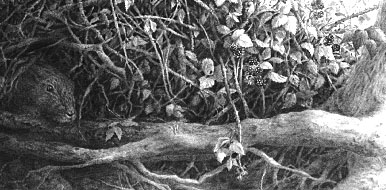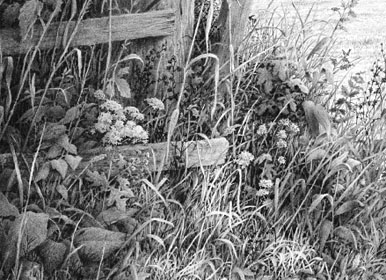HOW TO DRAW GRASSAn introduction to "Negative" drawing |
||||||||||||||||
|
Use of Negative Drawing in Art The title of this article is really too specific as the techniques described here apply as much to the drawing of hair as to grass. This is also an introduction to the use of "negative" drawing - drawing around white space, which only exists in your mind until you surround it with positive marks. I will cover "negative drawing" in more detail in a later article. 
So, what is "negative" drawing? What do you see when you look at this picture on the right? Do you see an ancient black drinking cup? Maybe an ebony candlestick holder? These are the positive images. Or do you see two white faces both looking at each other? Think of these faces as the negative areas or what I call "White Space". Imagine yourself "seeing" these two faces on a white sheet of paper and then filling in the space between them in black so the faces are revealed. This is Negative drawing - seeing the space and not the line. Teaching yourself to see White Space is one of the best lessons you will ever learn. DRAWING GRASS
You can of course draw grass in any way you choose from "sketchy" (which serves its purpose here as this drawing is just 1½" high and the grass exists only to place the tractor in space)... ...to where it plays a full role as an integral part of the "reality" of the drawing. In both cases the technique is much the same. The trick is to "think grass" and to work just fast enough to... Well, let me explain — SPEED FOOLS THE BRAIN 
It confuses the rational element that tries to control the creative side. Let your subconscious work, it always knows best. Consider the following two examples which, I think, prove the point. "The coconut shy principle"Pick up a ball, quickly turn around and throw it at a target the instant you see it. You will hit it nine times out of ten. Pick up the ball again, this time facing the target, take aim, compute initial speed of ejection required against the arc of decreasing velocity, include wind factors, the placement of your feet and resulting balance, the angle of your body to the target, equate these to your known muscular power, let fly...and miss! "The parking principle""...you think, you draw, it becomes reality..."Try slowly and carefully reversing a car into a tight parking space and you will often fail. Try it at speed (just slightly faster than your thinking process can function) and you will usually achieve success first time. I learnt this trick in my taxi driving days - it requires practice leading to confidence and, if you try it, don't send me your repair bills! In both principles, failure arises from letting your conscious mind dictate your actions and success comes from allowing your natural intuition to rule. In other words, you're trying too hard - just let it flow. The beauty of working in graphite is that you have a near-perfect mind-to-hand-to-image contact. Don't let your conscious mind interfere — you think, you draw, it becomes reality - in one unbroken and continuous process. So how do we translate this into grass (or hair)? DASH & REHASH v SLOW 'N STEADY
I have two basic ways of working - both equally justifiable - "dash and rehash" and "slow 'n steady". The first often works well and it's the one I recommend for drawing grass - it contains an element of spontaneity and some surprising results can emerge. It's quick, it's immediate and requires only a little, if any, retouching (the "rehash" element). We'll come back to "Slow 'n Steady" later and then combine the two. Imagine that there are only two marks that we can make: one upwards and one down. I'm going to use the upwards stroke to "draw" the stalks that spring up from the base of a clump of grass. The downward stroke is going to taper off and define the tops of the stalks in the clump below the one I'm drawing. The upward stroke draws a positive mark, the downstroke draws in negative. 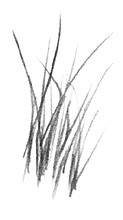 Working quickly, more strokes have been added...
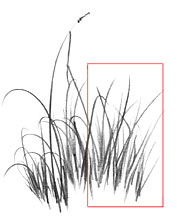 ...the area is expanded...
(the box encloses the previous image)  ...then I draw back down into the base to further define the white spaces.
 Below, the process has begun again - Positive strokes at the base draw into the negative shapes above and begin to define new white spaces below...
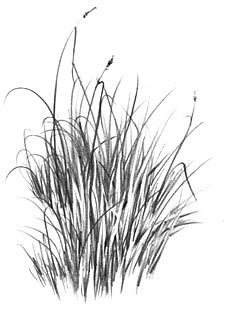 A degree of work in the central section blends the two together and a small amount of tone is being added to give body to the negatively drawn grass.
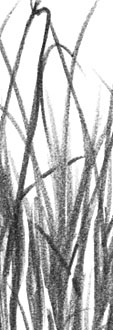 Note the occasional positive stroke that lies "behind" the negative stalks, throwing them forward...
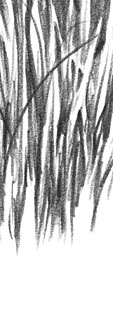 ...and in front to add depth.
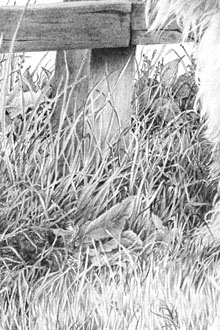 For clarity I've drawn these examples far larger than I would in normal use. Here you see an advanced version of the technique as I normally apply it.
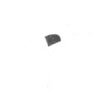 Picture a few white stalks on your white paper and define one space...
 ...fill in more spaces...
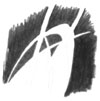 ...and more...
 ...until you've defined all the white space...
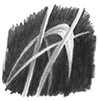 ...then add tone to fix the spatial relationships between them all.
| ||||||||||||||||
ART LESSONS |
|||
| ART BOOKS Drawing for Beginners |
PENCIL LESSONS The Eye |
DRAWING LESSONS Tips |
|
 |
 |
 |
|
| CHARCOAL LESSONS Female Nude |
CHARCOAL Nietzsche |
DRAWING LESSONS Grass |
|
 |
 |
 |
|
Drawing Lessons
Site Navigation |







